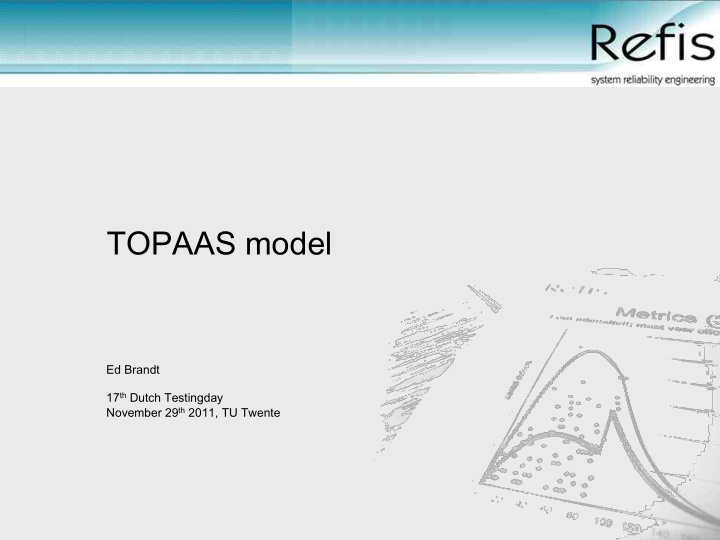



TOPAAS model Ed Brandt 17 th Dutch Testingday November 29 th 2011, TU Twente
� Introduction
� Reliability analysis � Reliability growth modelling � Monte Carlo � Formal methods � IEC 61508 (Safety Integrity Levels) � Factor driven model
� Requirements � Includes important parameters influencing software reliability � Applicable for custom made and COTS product � Aim at critical parts of software system � Accepted by industry � Supporting process management � Free of license agreements
� Result: TOPAAS-model T ask O riented P robability of A bnormalities A nalysis for S oftware
� Software failure � the absence (for too long) of desired task execution, or the incorrect task execution, by a software module with respect to the mission of the overall system,
� Software module � A piece of software that is represented by a specific group of lines source code (or its graphical equivalent) with the following properties: � A clear distinction can be made with respect to other pieces of code and there is clear separated functionality provided by the module that is required by the system; � It exhibits observable behavior with specific qualities (like timeliness, reliability, etc.); � It isn’t useful (in the light of the failure analysis on system level) or possible to make a further decomposition.
� Task Oriented No close command INWIN receives INWIN system wrong water Fails close levels command Subsystem A Subsystem B Fails close Fails close command command Input A Internal Input B Internal Out of Logical Out of Logical range failure range failure
� TOPAAS dimensions & factors Development process Requirements � � � Safety Integrity Level � traceability � Inspections Testing � � Design modifications � techniques and coverage � Maturity organisation Operational use � � Knowledge and experience � Multi processor � Cooperation � Field data available Product properties � � Monitoring � Complexity � Size � Transparancy architecture � Certified compiler
� Factor driven model � From mathematical point of view: factor driven model provides n factors Fi to determine failure probility P P = PB * F1 * F2 * ... * Fn � Where � PB is the base failure rate (1 as a conservative default value) � Fx is the impact of a specific factor based on a piece of knowledge
� Development process 2 Inspections Normal SIL3/SIL4 1 unknown 0 NVT 2 No inspections performed ! NVT 3 Inspections performed on design and code 0 ! 4 Documented Fagan inspections performed - " 0
� Testing 12 Test techniques and coverage Normal SIL3/SIL4 1 Unknown 0 NVT 2 No documented test execution 0 NVT 3 Documented test execution, no techniques, unknown - ! NVT coverage 4 Formal test techniques, low coverage - " # ! 5 Formal test techniques, medium coverage - # 6 Formal test techniques, high coverage -1 0 7 Formal test techniques, high documented coverage -1 ! - !
� TOPAAS dimensions execution / production development proces product requirements traceability testing environment 1 0,5 0 -0,5 variance in failure probability factor -1 -1,5 -2 -2,5 -3 -3,5
� Done & To be done � Done � Evaluation using reference models � Launch version 2 � Applied by several suppliers � To be done � Manual & tooling � Broad access & usage � Further review & referencing � Calibration against statistical data � Investigate correlation between software modules � User forum and model maintenance
� Credits � Authors � Alessandro Di Bucchianico (TU/e) � Jaap van Ekris (DNV) � Jan-Friso Groote (TU/e) � Wouter Geurts (Logica) � Gerben Heslinga (Intermedion) � Gea Kolk (Movares) � Ed Brandt (Refis) � Reviewers � Sipke van Manen (Bouwdienst RWS) � Harry van der Graaf (Bouwdienst RWS) � Peter van Gestel (Delta Pi) � Piet de Groot (NRG)
� TOPAAS paper � Download: http://www.refis.nl/media/artikelen.php � Comments: edbrandt@refis.nl
Recommend
More recommend